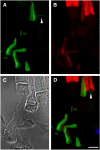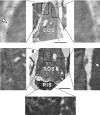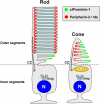Prominin-1 localizes to the open rims of outer segment lamellae in Xenopus laevis rod and cone photoreceptors
- PMID: 22076989
- PMCID: PMC3292372
- DOI: 10.1167/iovs.11-8635
Prominin-1 localizes to the open rims of outer segment lamellae in Xenopus laevis rod and cone photoreceptors
Abstract
Purpose: Prominin-1 expresses in rod and cone photoreceptors. Mutations in the prominin-1 gene cause retinal degeneration in humans. In this study, the authors investigated the expression and subcellular localization of xlProminin-1 protein, the Xenopus laevis ortholog of prominin-1, in rod and cone photoreceptors of this frog.
Methods: Antibodies specific for xlProminin-1 were generated. Immunoblotting was used to study the expression and posttranslational processing of xlProminin-1 protein. Immunocytochemical light and electron microscopy and transgenesis were used to study the subcellular distribution of xlProminin-1.
Results: xlProminin-1 is expressed and is subject to posttranslational proteolytic processing in the retina, brain, and kidney. xlProminin-1 is differently expressed and localized in outer segments of rod and cone photoreceptors of X. laevis. Antibodies specific for the N or C termini of xlProminin-1 labeled the open rims of lamellae of cone outer segments (COS) and the open lamellae at the base of rod outer segments (ROS). By contrast, anti-peripherin-2/rds antibody, Xper5A11, labeled the closed rims of cone lamellae adjacent to the ciliary axoneme and the rims of the closed ROS disks. The extent of labeling of the basal ROS by anti-xlProminin-1 antibodies varied with the light cycle in this frog. The entire ROS was also faintly labeled by both antibodies, a result that contrasts with the current notion that prominin-1 localizes only to the basal ROS.
Conclusions: These findings suggest that xlProminin-1 may serve as an anti-fusogenic factor in the regulation of disk morphogenesis and may help to maintain the open lamellar structure of basal ROS and COS disks in X. laevis photoreceptors.
Figures










Similar articles
-
Characterization of peripherin/rds and rom-1 transport in rod photoreceptors of transgenic and knockout animals.Invest Ophthalmol Vis Sci. 2006 May;47(5):2150-60. doi: 10.1167/iovs.05-0919. Invest Ophthalmol Vis Sci. 2006. PMID: 16639027 Free PMC article.
-
Localization of peripherin/rds in the disk membranes of cone and rod photoreceptors: relationship to disk membrane morphogenesis and retinal degeneration.J Cell Biol. 1992 Feb;116(3):659-67. doi: 10.1083/jcb.116.3.659. J Cell Biol. 1992. PMID: 1730772 Free PMC article.
-
Peripherin-2 and ROM1 Incorporate Directly Into the Rims of Enclosing Photoreceptor Discs Without Accumulating in the Nascent Disc Lamellae.Invest Ophthalmol Vis Sci. 2025 Aug 1;66(11):33. doi: 10.1167/iovs.66.11.33. Invest Ophthalmol Vis Sci. 2025. PMID: 40801673 Free PMC article.
-
Prominin-1 and Photoreceptor Cadherin Localization in Xenopus laevis: Protein-Protein Relationships and Function.Adv Exp Med Biol. 2019;1185:483-487. doi: 10.1007/978-3-030-27378-1_79. Adv Exp Med Biol. 2019. PMID: 31884658 Review.
-
Molecular basis for photoreceptor outer segment architecture.Prog Retin Eye Res. 2016 Nov;55:52-81. doi: 10.1016/j.preteyeres.2016.05.003. Epub 2016 Jun 1. Prog Retin Eye Res. 2016. PMID: 27260426 Free PMC article. Review.
Cited by
-
Spatial distribution of prominin-1 (CD133)-positive cells within germinative zones of the vertebrate brain.PLoS One. 2013 May 27;8(5):e63457. doi: 10.1371/journal.pone.0063457. Print 2013. PLoS One. 2013. PMID: 23723983 Free PMC article.
-
Protein sorting, targeting and trafficking in photoreceptor cells.Prog Retin Eye Res. 2013 Sep;36:24-51. doi: 10.1016/j.preteyeres.2013.03.002. Epub 2013 Apr 3. Prog Retin Eye Res. 2013. PMID: 23562855 Free PMC article. Review.
-
Photoreceptors at a glance.J Cell Sci. 2015 Nov 15;128(22):4039-45. doi: 10.1242/jcs.175687. J Cell Sci. 2015. PMID: 26574505 Free PMC article. Review.
-
Deletion of the transmembrane protein Prom1b in zebrafish disrupts outer-segment morphogenesis and causes photoreceptor degeneration.J Biol Chem. 2019 Sep 20;294(38):13953-13963. doi: 10.1074/jbc.RA119.008618. Epub 2019 Jul 30. J Biol Chem. 2019. PMID: 31362982 Free PMC article.
-
Glycosylation of rhodopsin is necessary for its stability and incorporation into photoreceptor outer segment discs.Hum Mol Genet. 2015 May 15;24(10):2709-23. doi: 10.1093/hmg/ddv031. Epub 2015 Jan 30. Hum Mol Genet. 2015. PMID: 25637522 Free PMC article.
References
-
- Young RW. Passage of newly formed protein through the connecting cilium of retina rods in the frog. J Ultrastruct Res. 1968;23:462–473 - PubMed
-
- Papermaster DS, Schneider BG, Besharse JC. Vesicular transport of newly synthesized opsin from the Golgi apparatus toward the rod outer segment: ultrastructural immunocytochemical and autoradiographic evidence in Xenopus retinas. Invest Ophthalmol Vis Sci. 1985;26:1386–1404 - PubMed
-
- Roepman R, Wolfrum U. Protein networks and complexes in photoreceptor cilia. Subcell Biochem. 2007;43:209–235 - PubMed
-
- Yau KW. Phototransduction mechanism in retinal rods and cones: the Friedenwald Lecture. Invest Ophthalmol Vis Sci. 1994;35:9–32 - PubMed
Publication types
MeSH terms
Substances
Grants and funding
LinkOut - more resources
Full Text Sources
Research Materials

